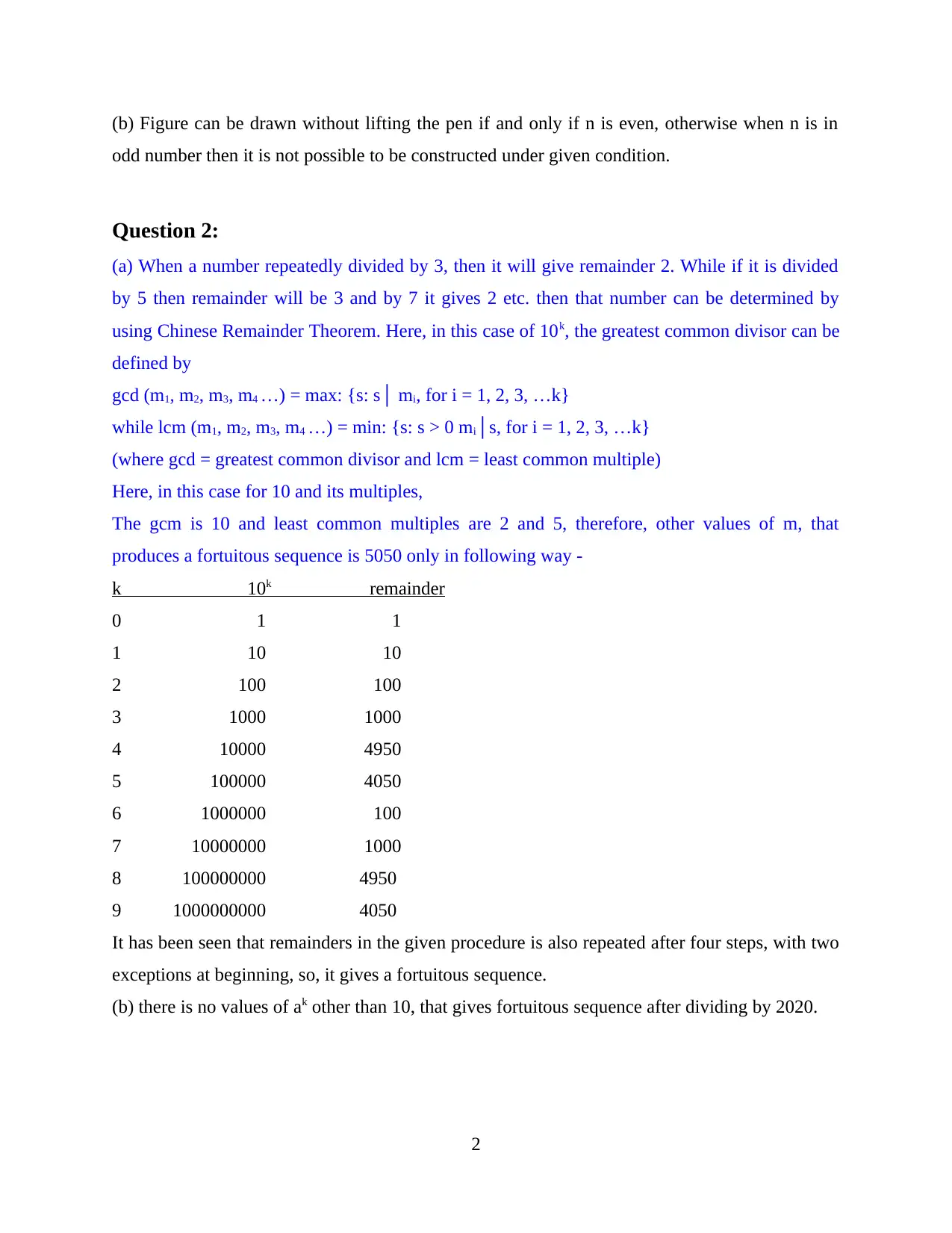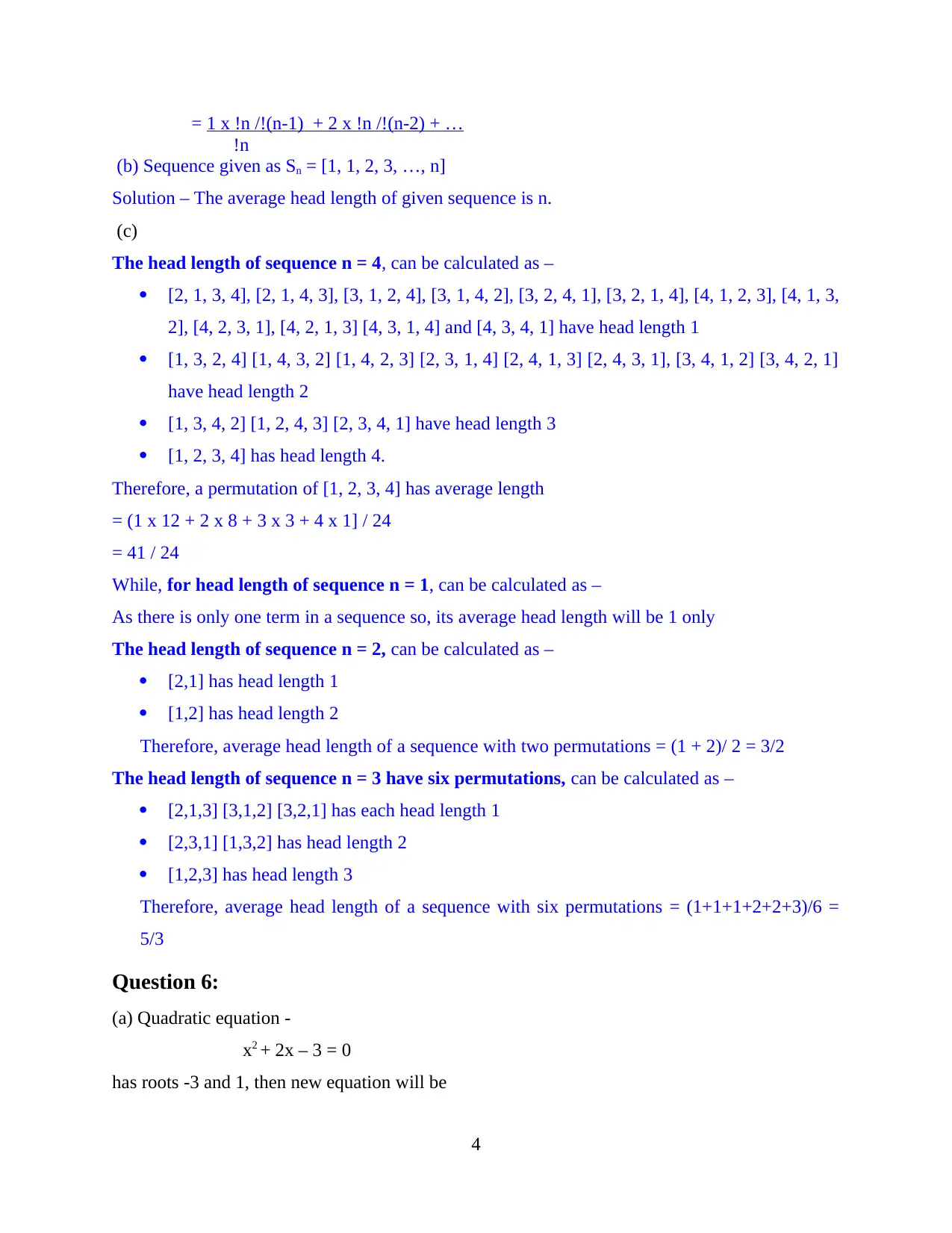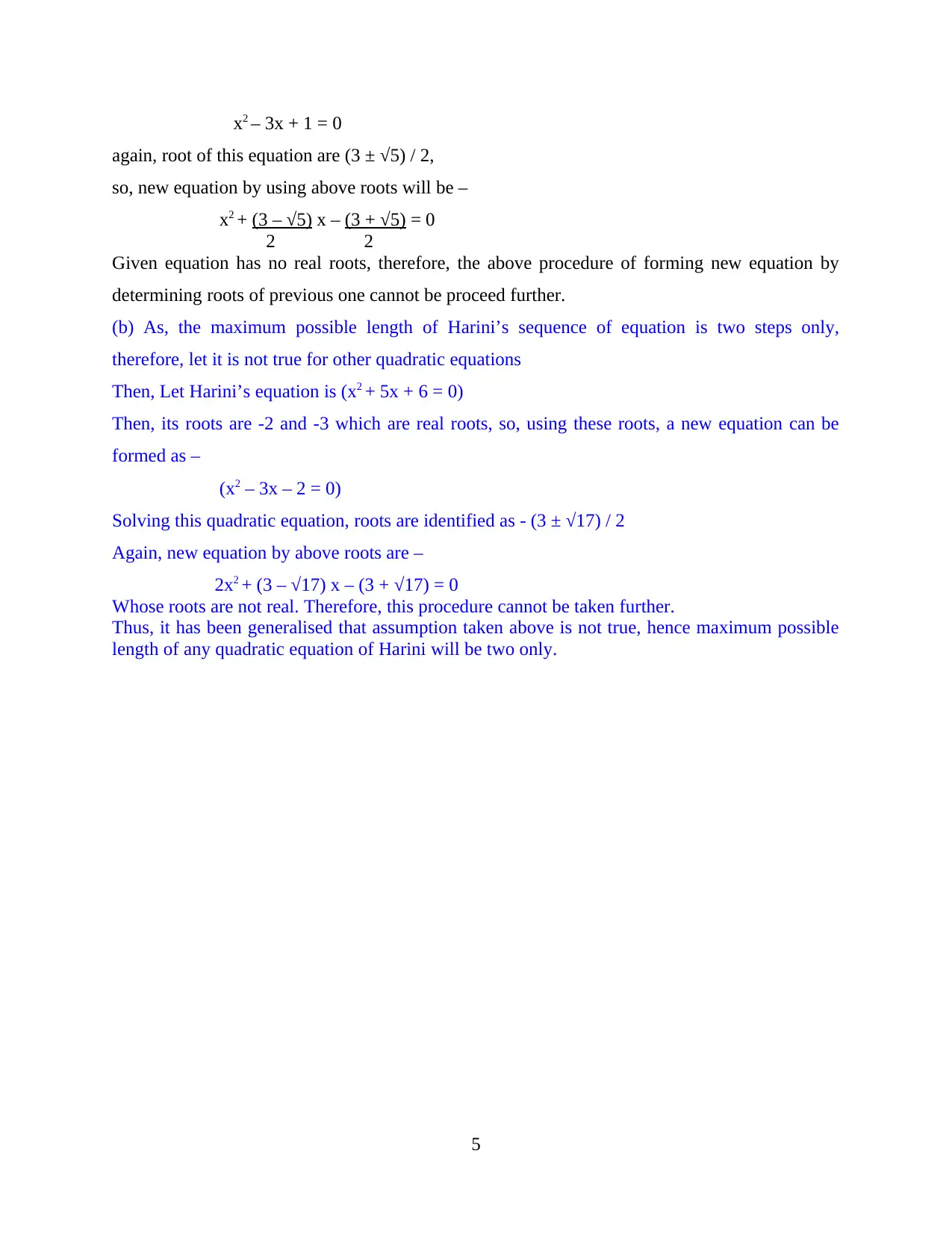Math Problems Solution: Foundations of Mathematics Assignment
VerifiedAdded on 2023/01/13
|7
|1406
|56
Homework Assignment
AI Summary
This document presents solutions to a series of math problems. The solutions cover various concepts, including determining conditions for drawing figures without lifting a pen, applying the Chinese Remainder Theorem, and analyzing quadratic equations. It also delves into sequence analysis, calcula...

Maths Problems
Paraphrase This Document
Need a fresh take? Get an instant paraphrase of this document with our AI Paraphraser


Question 1:
(a)
1
(a)
1
You're viewing a preview
Unlock full access by subscribing today!

(b) Figure can be drawn without lifting the pen if and only if n is even, otherwise when n is in
odd number then it is not possible to be constructed under given condition.
Question 2:
(a) When a number repeatedly divided by 3, then it will give remainder 2. While if it is divided
by 5 then remainder will be 3 and by 7 it gives 2 etc. then that number can be determined by
using Chinese Remainder Theorem. Here, in this case of 10k, the greatest common divisor can be
defined by
gcd (m1, m2, m3, m4 …) = max: {s: s│ mi, for i = 1, 2, 3, …k}
while lcm (m1, m2, m3, m4 …) = min: {s: s > 0 mi│s, for i = 1, 2, 3, …k}
(where gcd = greatest common divisor and lcm = least common multiple)
Here, in this case for 10 and its multiples,
The gcm is 10 and least common multiples are 2 and 5, therefore, other values of m, that
produces a fortuitous sequence is 5050 only in following way -
k 10k remainder
0 1 1
1 10 10
2 100 100
3 1000 1000
4 10000 4950
5 100000 4050
6 1000000 100
7 10000000 1000
8 100000000 4950
9 1000000000 4050
It has been seen that remainders in the given procedure is also repeated after four steps, with two
exceptions at beginning, so, it gives a fortuitous sequence.
(b) there is no values of ak other than 10, that gives fortuitous sequence after dividing by 2020.
2
odd number then it is not possible to be constructed under given condition.
Question 2:
(a) When a number repeatedly divided by 3, then it will give remainder 2. While if it is divided
by 5 then remainder will be 3 and by 7 it gives 2 etc. then that number can be determined by
using Chinese Remainder Theorem. Here, in this case of 10k, the greatest common divisor can be
defined by
gcd (m1, m2, m3, m4 …) = max: {s: s│ mi, for i = 1, 2, 3, …k}
while lcm (m1, m2, m3, m4 …) = min: {s: s > 0 mi│s, for i = 1, 2, 3, …k}
(where gcd = greatest common divisor and lcm = least common multiple)
Here, in this case for 10 and its multiples,
The gcm is 10 and least common multiples are 2 and 5, therefore, other values of m, that
produces a fortuitous sequence is 5050 only in following way -
k 10k remainder
0 1 1
1 10 10
2 100 100
3 1000 1000
4 10000 4950
5 100000 4050
6 1000000 100
7 10000000 1000
8 100000000 4950
9 1000000000 4050
It has been seen that remainders in the given procedure is also repeated after four steps, with two
exceptions at beginning, so, it gives a fortuitous sequence.
(b) there is no values of ak other than 10, that gives fortuitous sequence after dividing by 2020.
2
Paraphrase This Document
Need a fresh take? Get an instant paraphrase of this document with our AI Paraphraser

Question 3:
(a) Taking assumption that Red Road doesn’t intersect Green Road then, b = 0 and a = 1,
So, (b – a) = (1 – 0) = 1
(b) Set of possible values –
If Green road is chosen to reach Campville from Mathopolis then a = 0, b = 2,
So, (b – a) = (2 – 0) = 2
If Red road is selected then, a = 1, b = 1
So, (b – a) = (1 – 1) = 0
And if, Blue Road is chosen then, a = 0, b = 2
So, (b – a) = (2 – 1) = 1
Question 5:
(a) Given Sequence Sn = [1, 2, 3, …n]
(i) Fraction of head length 1 of Sn
Solution – The permutations of given sequence is !n, by using the formula
nPr = !n /!(n-r) where r = n
so, fraction of head length 1 of given sequence will be –
nP1 = !n /!(n-1)
(ii) Fraction of head length k of Sn
Solution: For head length k in n number of permutations will be –
nPk = !n /!(n-k)
(iii) Average head length of a permutation of given sequence n
Solution: Average head length of n number of permutation will be
3
(a) Taking assumption that Red Road doesn’t intersect Green Road then, b = 0 and a = 1,
So, (b – a) = (1 – 0) = 1
(b) Set of possible values –
If Green road is chosen to reach Campville from Mathopolis then a = 0, b = 2,
So, (b – a) = (2 – 0) = 2
If Red road is selected then, a = 1, b = 1
So, (b – a) = (1 – 1) = 0
And if, Blue Road is chosen then, a = 0, b = 2
So, (b – a) = (2 – 1) = 1
Question 5:
(a) Given Sequence Sn = [1, 2, 3, …n]
(i) Fraction of head length 1 of Sn
Solution – The permutations of given sequence is !n, by using the formula
nPr = !n /!(n-r) where r = n
so, fraction of head length 1 of given sequence will be –
nP1 = !n /!(n-1)
(ii) Fraction of head length k of Sn
Solution: For head length k in n number of permutations will be –
nPk = !n /!(n-k)
(iii) Average head length of a permutation of given sequence n
Solution: Average head length of n number of permutation will be
3

= 1 x !n /!(n-1) + 2 x !n /!(n-2) + …
!n
(b) Sequence given as Sn = [1, 1, 2, 3, …, n]
Solution – The average head length of given sequence is n.
(c)
The head length of sequence n = 4, can be calculated as –
[2, 1, 3, 4], [2, 1, 4, 3], [3, 1, 2, 4], [3, 1, 4, 2], [3, 2, 4, 1], [3, 2, 1, 4], [4, 1, 2, 3], [4, 1, 3,
2], [4, 2, 3, 1], [4, 2, 1, 3] [4, 3, 1, 4] and [4, 3, 4, 1] have head length 1
[1, 3, 2, 4] [1, 4, 3, 2] [1, 4, 2, 3] [2, 3, 1, 4] [2, 4, 1, 3] [2, 4, 3, 1], [3, 4, 1, 2] [3, 4, 2, 1]
have head length 2
[1, 3, 4, 2] [1, 2, 4, 3] [2, 3, 4, 1] have head length 3
[1, 2, 3, 4] has head length 4.
Therefore, a permutation of [1, 2, 3, 4] has average length
= (1 x 12 + 2 x 8 + 3 x 3 + 4 x 1] / 24
= 41 / 24
While, for head length of sequence n = 1, can be calculated as –
As there is only one term in a sequence so, its average head length will be 1 only
The head length of sequence n = 2, can be calculated as –
[2,1] has head length 1
[1,2] has head length 2
Therefore, average head length of a sequence with two permutations = (1 + 2)/ 2 = 3/2
The head length of sequence n = 3 have six permutations, can be calculated as –
[2,1,3] [3,1,2] [3,2,1] has each head length 1
[2,3,1] [1,3,2] has head length 2
[1,2,3] has head length 3
Therefore, average head length of a sequence with six permutations = (1+1+1+2+2+3)/6 =
5/3
Question 6:
(a) Quadratic equation -
x2 + 2x – 3 = 0
has roots -3 and 1, then new equation will be
4
!n
(b) Sequence given as Sn = [1, 1, 2, 3, …, n]
Solution – The average head length of given sequence is n.
(c)
The head length of sequence n = 4, can be calculated as –
[2, 1, 3, 4], [2, 1, 4, 3], [3, 1, 2, 4], [3, 1, 4, 2], [3, 2, 4, 1], [3, 2, 1, 4], [4, 1, 2, 3], [4, 1, 3,
2], [4, 2, 3, 1], [4, 2, 1, 3] [4, 3, 1, 4] and [4, 3, 4, 1] have head length 1
[1, 3, 2, 4] [1, 4, 3, 2] [1, 4, 2, 3] [2, 3, 1, 4] [2, 4, 1, 3] [2, 4, 3, 1], [3, 4, 1, 2] [3, 4, 2, 1]
have head length 2
[1, 3, 4, 2] [1, 2, 4, 3] [2, 3, 4, 1] have head length 3
[1, 2, 3, 4] has head length 4.
Therefore, a permutation of [1, 2, 3, 4] has average length
= (1 x 12 + 2 x 8 + 3 x 3 + 4 x 1] / 24
= 41 / 24
While, for head length of sequence n = 1, can be calculated as –
As there is only one term in a sequence so, its average head length will be 1 only
The head length of sequence n = 2, can be calculated as –
[2,1] has head length 1
[1,2] has head length 2
Therefore, average head length of a sequence with two permutations = (1 + 2)/ 2 = 3/2
The head length of sequence n = 3 have six permutations, can be calculated as –
[2,1,3] [3,1,2] [3,2,1] has each head length 1
[2,3,1] [1,3,2] has head length 2
[1,2,3] has head length 3
Therefore, average head length of a sequence with six permutations = (1+1+1+2+2+3)/6 =
5/3
Question 6:
(a) Quadratic equation -
x2 + 2x – 3 = 0
has roots -3 and 1, then new equation will be
4
You're viewing a preview
Unlock full access by subscribing today!

x2 – 3x + 1 = 0
again, root of this equation are (3 ± √5) / 2,
so, new equation by using above roots will be –
x2 + (3 – √5) x – (3 + √5) = 0
2 2
Given equation has no real roots, therefore, the above procedure of forming new equation by
determining roots of previous one cannot be proceed further.
(b) As, the maximum possible length of Harini’s sequence of equation is two steps only,
therefore, let it is not true for other quadratic equations
Then, Let Harini’s equation is (x2 + 5x + 6 = 0)
Then, its roots are -2 and -3 which are real roots, so, using these roots, a new equation can be
formed as –
(x2 – 3x – 2 = 0)
Solving this quadratic equation, roots are identified as - (3 ± √17) / 2
Again, new equation by above roots are –
2x2 + (3 – √17) x – (3 + √17) = 0
Whose roots are not real. Therefore, this procedure cannot be taken further.
Thus, it has been generalised that assumption taken above is not true, hence maximum possible
length of any quadratic equation of Harini will be two only.
5
again, root of this equation are (3 ± √5) / 2,
so, new equation by using above roots will be –
x2 + (3 – √5) x – (3 + √5) = 0
2 2
Given equation has no real roots, therefore, the above procedure of forming new equation by
determining roots of previous one cannot be proceed further.
(b) As, the maximum possible length of Harini’s sequence of equation is two steps only,
therefore, let it is not true for other quadratic equations
Then, Let Harini’s equation is (x2 + 5x + 6 = 0)
Then, its roots are -2 and -3 which are real roots, so, using these roots, a new equation can be
formed as –
(x2 – 3x – 2 = 0)
Solving this quadratic equation, roots are identified as - (3 ± √17) / 2
Again, new equation by above roots are –
2x2 + (3 – √17) x – (3 + √17) = 0
Whose roots are not real. Therefore, this procedure cannot be taken further.
Thus, it has been generalised that assumption taken above is not true, hence maximum possible
length of any quadratic equation of Harini will be two only.
5
1 out of 7
Related Documents
Your All-in-One AI-Powered Toolkit for Academic Success.
+13062052269
info@desklib.com
Available 24*7 on WhatsApp / Email
![[object Object]](/_next/static/media/star-bottom.7253800d.svg)
Unlock your academic potential
© 2024 | Zucol Services PVT LTD | All rights reserved.




